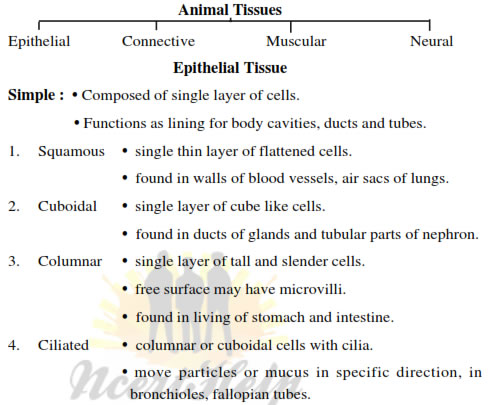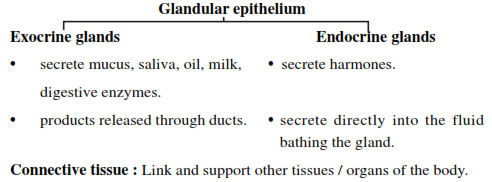
structural organisation in animals ncert notes download pdf, solution of ncert, ncert solutions, ncert solution, solutions of ncert, ncert solution of, ncert textbooks solutions, solution ncert, solution for ncert, ncert solutions download, solutions ncert, all ncert solutions, ncert solut, ncert solutions for class 1, ncert solutions 7 , structural organisation in animals 11 notes, class 11 biology notes, structural organisation in animals class 11, structural organisation in animals class 11 notes, class 11 structural organisation in animals, note biology, biology notes, structural organisation in animals, class 11 cbiology chapter 7 notes, 11th standard biology notes, 11th std biology notes, class 11 biology notes chapter 7, structural organisation in animals chapter class 11
Tissue : A group of similar cells along with intercellular substances which
perform a specific function.
Simple epithelium : is composed of a single layer of cells resting on a
basement membrane.
Compound epithelium : consists of two or more cell layers and has protective
function.
Areolar tissue : is a type of loose connective tissue present beneath the
skin.
Adipose tissue : is a type of loose connective tissue which has cells
specialised to store fats.
Neuroglia : A delicate connective tissue which supports and binds together
the nerve tissue in the Central Nervous Tissue.
Malpighian tubules : Yellow coloured thin, filamentous tubules present at
the junction of midgut and hindgut in cockroach; helps in excretion.
Uricotelic : Animals which excrete nitrogenous waste in the form of uric
acid.
Tight junctions : Plasma membranes of adjacent cells are fused at intervals.
They help to stop substances from leaking across a tissue.
Adhering junctions : Perform cementing function to keep neighbouring
cells together.
Gap junction : Facilitate the cells to communicate with each other by connecting
the cytoplasm of adjoining cells for rapid transfer of ions, small molecules
and sometimes big molecules.

•Made of more than one layer of cells.
• Provide protection against chemical and mechanical stresses.
• Cover dry surface of skin, moist cavity, pharynx, inner lining of ducts
of salivary glands and pancreatic ducts.

Loose Connective Tissue
(has cells and fibres loosely arranged in semi-fluid ground substance)
(i) Areolar Tissue :
• present beneath the skin.
• contains fibroblasts, macrophages and mast cells.
• serves as a support framework for epithelium.
(ii) Adipase Tissue :
• located beneath the skin.
• cells are specialised to store fats.
Dense Connective Tissue
Fibres and fibroblasts are compactly packed.
(i) Dense Regular :
• Collagen fibres present in rows.
• Tendons attach skeletal muscle to bone.
• Ligaments attach bone to bone.
(ii) Dense Irregular :
• Has collagen fibres and fibroblasts oriented differently.
• This tissue is present in the skin.
Specialised Connective Tissue
(i) Cartilage made up of chondrocytes and collegen fibres.
(ii) Bones Ground substance is rich in calcium salts and collegen
fibres Osteocytes are present in lacunae
(iii) Blood Fluid connective tissue, consists of plasma and blood cells
Muscle Tissue
Consists of long, highly contractile cells called fibres; bring about move-
ment and locomotion.
(i) Skeletal Muscle :
• Consists of long cylindrical, multinucleated fibres.
• Closely attached to skeletal bones.
• Striated.
(ii) Smooth Muscles :
• Consists of spindle like, uninucleated fibres.
• Do not show striations.
• Wall of internal organs such as blood vessels, stomach and intestine.
(iii) Cardiac Muscles :
• Short, cylindrical, uninucleated fibres.
• Occur in the heart wall.
• Intercalated discs for communication.
Neural Tissue
• Neurons are the functional unit and are excitable cells.
• Neuroglia cells make up more than half the volume of neural tissue.
They protect and support neurons.
Cockroach − Periplaneta americana
is a terrestrial, nocturnal, omnivorous, unisexual, oviparous insect. Body
covered by a chitinous, hard exoskeleton of hard plates called sclerites.
Head : Triangular, formed by fusion of 6 segments. Bears a pair of anten-
nae, compound eyes. Mouth parts consists of labrum (upper lip), a pair of mandibles,
a pair of maxillae, labium (lower lip), hypopharynx (acts as tongue).
Thorax : 3 segments; prothorax, mesothorax and metathorax.
Bears 2 pairs
of wings : Forewings : tegmina (mesothoracic).
Hindwings : transparent, membranous (metathoracic) and 3 pairs of legs in
thoracic segments.
Abdomen : 10 segments. Bears a pair of long, segmented anal cerci in
both sexes and a pair of short, unjoined anal styles in males only.
Also has anus and genital aperture at the hind end. Genital aperture sur-
rounded by external genitalia called gonapophysis or phallomere.
Anatomy : Study of the morphology of internal organs.
Alimentary canal : Divided into foregut, midgut and hindgut.
Mouth → Pharynx → Oesophagus → Crop (stores food) → Gizzard (grind-
ing of food) → Hepatic caeca (at junction of fore and midgut; secretes digestive
juice) → Hindgut (ileum, colon, rectum) → Anus.
Blood vascular system : Open type, visceral organs bathed in haemolymph
(colourless plasma and haemocytes).
Heart consists of enlongated mascular tube and differentiated into funnelshaped
chambers with ostia on either side. Blood from sinuses enters heart through
ostia
and is pumped anteriorly to sinuses again. Blood colourless (haemolymph).
Repiratory system : Network of trachea which open through 10 spiracles.
Spiracles regulated by sphincters. Oxygen delivered directly to cells. Excretion
and osmoregulation by Malpighian tubules; uricotelic (Uric acid as excretory
product).
Nervous system : Consists of series of fused segmentally arranged ganglia
joined by paired longitudinally connectives on the ventral side. three ganglia in
thorax, six in abdomen. Brain represented by supra-oesophageal ganglion.
Reproductive system : Male − Pair of testes (4th-6th segments) → vas deferens → ejaculatory duct
→ male gonophore.
Glands − Seminal vesicle (stores sperms), mushroom shaped gland (6th-
7th segment).
Female reproductive system : A pair of ovaries (with 8 ovarian tubules) → Oviduct → Genital chamberSperms transferred through spermatophores. Fertilised eggs encased in cap-
sules called oothecae; development of P. americana paurometabolous (incomplete
metamorphosis).
Nymph grows by moulting 13 times to reach adult form.
Interaction with man
• Pests as destroy food and contaminate it.
• Can transmit a variety of bacterial diseases (Vector).
Copyright @ ncerthelp.com A free educational website for CBSE, ICSE and UP board.